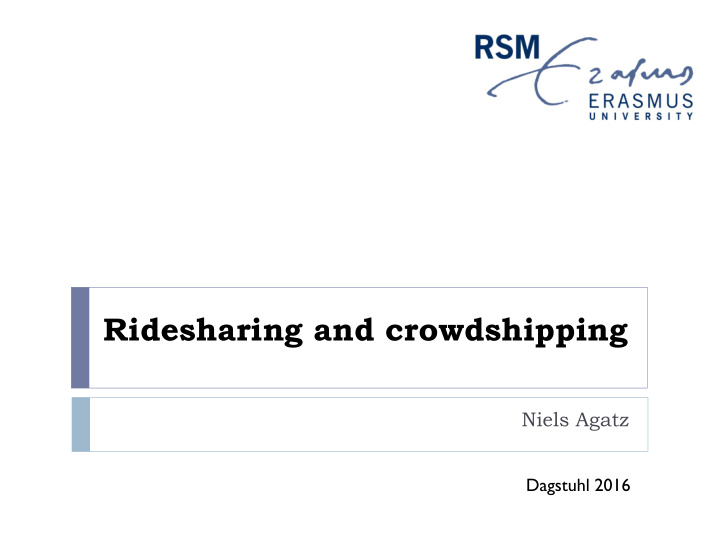



Ridesharing and crowdshipping Niels Agatz Dagstuhl 2016
New ways of business: collaborative consumption
Make use of journeys that are already happening Low occupancy rate of cars (1.2-1.8)
People: dynamic ridesharing
Dynamic ridesharing features Dynamic: established on short-notice Non-recurring trips: different from carpooling Automated matching: different from online notice-boards Independent drivers: different from taxis Cost-sharing: variable trip related expenses Prearranged: different from spontaneous, casual ride- sharing
Various providers
Freight: crowdsourced delivery
Various providers
Dynamic ride-share variants Single rider Multiple riders Single driver Easy (Bipartite Difficult (Routing) Matching) Multiple drivers Difficult (Transfers) Difficult (Routing + Transfers)
Who are the drivers?
What motivates drivers? Help others /neighbors / the community Save the environment Make some extra money Different driver payment schemes: hourly payment, per mile, per task…
Business model of providers Platform to create matches and arrange payments Platform takes a cut for providing the infrastructure Backup option to guarantee timely service?
Critical success factors Drivers: ↓ inconvenience Society: ↓ traffic and congestion Rider/ sender: ↓ costs ↑ speed, convenience, mobility Maximize the number of matched riders/ parcels 1. Minimize total vehicle miles in system 2.
How to establish matches? Decentralized approach Centralized automated matching
Dynamics
Driver considerations How much time does the driver have available? Information exchange: departure time alone may not suffice departure time flexibility? travel time flexibility? stops flexibility?
Driver time information Departure time Announcement Earliest Latest arrival time time Latest Lead-time flexibility direct travel time time window for matching
How many stops is the driver willing to make? Task Driver One stop Two stops
Other considerations friends ↔ strangers neighbors ↔ strangers Enable trust/ safety / reliability
Ensure safety/ reliability
Project 1: dynamic ridesharing Two-way matching of drivers and riders Impact of dynamics Impact of role flexibility
Project 2: stable rideshare matching
Project 3: ridesharing meeting points
Project 4: ridesharing flexibility
Project 5: crowdsourced delivery
Key challenges to make this work
1. Building demand and supply How to reach a critical mass fast? What incentives can be offered? How to organize the backup?
2. Dealing with uncertainty How to make sure that you have enough drivers when you need them? Dynamic incentives?
3. Regulatory issues
Work in progress Simulation study based on actual traffic data Combined ridesharing and public transport Crowdsourcing with transfers
Papers Stiglic, M, Agatz, N.A.H., Savelsbergh, M.W.P. & Gradisar, M. (2016). The Benefits of Meeting Points in Ride-Sharing Systems. Transportation Research. Part B, Methodological, Agatz, N.A.H., Erera, A., Savelsbergh, M.W.P. & Wang, X. (2012). Optimization for Dynamic Ride-Sharing: A Review. European Journal of Operational Research, 223 (2), 295-303. Agatz, N.A.H., Erera, A., Savelsbergh, M.W.P. & Wang, X. (2011). Dynamic Ride-Sharing: A Simulation Study in Metro Atlanta. Transportation Research. Part B, Methodological, 45 (9), 1450-1464. X Wang, N Agatz, A Erera, Stable matching for dynamic ride-sharing systems, ERIM Report Series Reference No. ERS-2015-006-LIS Arslan, Alp and Agatz, Niels and Kroon, Leo G. and Zuidwijk, Rob A., Crowdsourced Delivery -- A Pickup and Delivery Problem with Ad-Hoc Drivers (February 2, 2016). ERIM Report Series Reference. Stiglic, M, Agatz, N.A.H., Savelsbergh, M.W.P. & Gradisar, M. (2016). Making Dynamic Ride-sharing Work:The Impact of Driver and Rider Flexibility
Collaborators Alp Arslan Alan Erera Leo Kroon Martin Savelsbergh Mitja Stiglic Xing Wang Rob Zuidwijk
Recommend
More recommend